Interviews:
Julia Getsiv
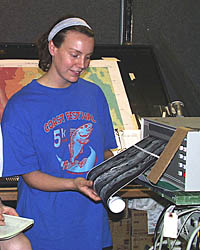 Julia (left) studies the seafloor volcanic features that are being
displayed on the DSL-120 sonar image printer during one of the surveys. Julia (left) studies the seafloor volcanic features that are being
displayed on the DSL-120 sonar image printer during one of the surveys.
Question:
Did growing up around the Pacific Ocean get you interested in Oceanography?
Julia:
Yes, I have always been fascinated with the ocean. When I was little, all I ever
wanted to do on weekends and during school breaks was go to the beach. It was
a wonderful place to dream and explore.
 |
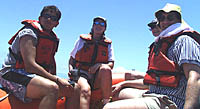 |
| Julia
(center) taking a spin in RV Melville’s rescue
boat with Jon Burgess (left), Maya Tolstoy (background
right), and Dan Scheirer. |
Question:
What did you want to be when you grew up?
Julia:
My family thought I would grow up to be some type of biologist because, when
I was little, I was fascinated with caterpillars and was always looking for them
and making observations about them. My best friend and I would spend every day
after school and all weekend long looking for them in trees and turned over leaves,
wherever they might be. I began to see myself as a scientist when I entered and
won a science fair in 6th grade with my bean plant study. I grew bean plants
under all sorts of different conditions to see what happened to them. In junior
high school, I took an Earth Science course where I first learned about plate
tectonics. I got really excited when I found out how the plates move around on
the surface of the Earth and have been hooked on geology ever since.
Question:
When did you get interested in the oceans and decide to work on research ships?
 |
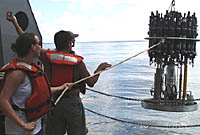 |
| Julia
tending the recovery line to the CTD rosette sampling system during
its recovery. Rob Palomares, the CTD technician, is directing the operation
and giving signals to the winch operator. |
Julia:
It was in 10th grade that I decided I wanted to major in oceanography,
but I was discouraged by one of the school counselors who said
I wouldn’t be
able to get a job in the field. Then I considered becoming a teacher, and headed
to college to get a teaching degree. I wasn’t satisfied with what I was
learning though, and wanted to first gain greater knowledge in the subject I
would be teaching, so I transferred to the University of Washington. My first
science course there was Oceanography, and I felt at home from the very first
class. In 1993, I graduated with a degree in Oceanography and a concentration
in Geology.
Question:
What did you do after you graduated?
Julia:
I was really lucky because the day before graduation I got a job working with
the NOAA group in Newport Oregon. It was so exciting to be doing real science
in a field I loved. In fact, I was really lucky because my first cruise was out
to the CoAxial site on the Juan de Fuca Ridge, where they first detected a seafloor
eruption in 1993 using the SOSUS hydrophone array. I had been on short cruises
in school, but never out in the deep ocean. It was very exciting to be out on
a research vessel with geologists, biologists, chemists, and physical oceanographers
who were studying the different characteristics of a submarine eruption on the
mid-ocean ridge.
Question:
Have you continued to work for NOAA since that time?
 |
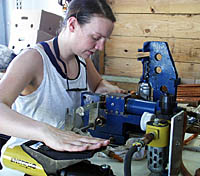 |
| Julia
is crimping the copper tubing that contains water samples collected
by the CTD system from the diffuse flow hydrothermal field sampled
today. The water samples will be analyzed by Dr. John Lupton of
NOAA who is a specialist in helium analysis of ocean water. |
Julia:
No, I worked for NOAA at Hatfield Marine Science Center until 1996, and then
went to Vanderbilt University to get a Masters Degree in Geology. My thesis
work involved studying landslides on the steep rift valley walls of the Mid-Atlantic
Ridge. I mapped and classified the style of landslides and used stability
analysis models based on terrestrial landslides to understand the mechanics
of the landslides I mapped on the Mid-Atlantic Ridge.
I started to work for Chris Fox, at NOAA, during the summers while I was
in graduate school, and began working full-time in Newport at the Hatfield
Marine Science Center for him after I graduated from Vanderbilt in 1999.
That’s how I
got involved with detecting eruptions on the seafloor. I am also involved in
interpreting JASON and ALVIN dive data that the NOAA group has collected over
the past few years, and I have continued to go to sea with them each summer.
Recently, I worked on mapping the flow morphologies of the 1998 lava flow that
occurred on Axial Seamount on the Juan de Fuca Ridge. This will be used in a
web page developed by Bill Chadwick from NOAA that will enable the viewer to “fly” over
the lava flow and explore specific sites with video clips along the way.
Ultimately, I want to go back to teaching secondary school kids. In graduate
school, I taught physical geology and oceanography lab courses and really enjoyed
it. I especially like the challenge of finding how to reach each student. We
all have different learning styles and, in a classroom, you never know what will
work best for each one. Finding that way to connect, and seeing the excitement
in their eyes when they understand, is very rewarding.
 |
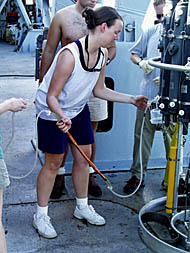 |
| Julia
draws a sample from one of the Niskin bottles on the CTD rosette sampling
system. The white rubber tubing is attached to the white nozzle on
the bottom of bottle, and the sample is collected in the copper tube
that Julia is holding. Great care has to be taken so that there is
no contamination either between samples from different bottles or anything
that is on their hands or on the ship. |
Question:
What are your duties while on the Melville?
Julia:
My primary duties are to process the DSL-120 sidescan sonar and bathymetry
data. I also take a lot of the pictures that have appeared on the web site,
and I help Dan with some of the daily updates, figure captions and quizzes.
I also stand watch like the other scientists and when I’m not processing,
I help out in the van. Oh, and I love harassing the Shellbacks whenever I get
a chance!
Question:
What other interests do you have?
Julia:
On board I like to workout, read and send e-mail (mostly to my fiancé!).
At home, I like to go hiking, camping and canoeing. Anything that gets me outdoors
and moving. I also have an ever-growing collection of moose things -- like
stuffed toys, mugs, cups, statues, and clothing. One of my favorite after-work
activities that I have been doing since 1994 is teaching aerobics at the YMCA
-- kick-boxing, step aerobics, and muscle conditioning classes. Kick-boxing
is my favorite and I have been teaching some people on board the ship to do
it. It is a little difficult because of the motion of the ship, but we all
enjoy it.
Question:
What is your favorite part of your job?
Julia:
I love the excitement and intensity of research cruises. It’s intense to
be exploring around the clock. You never know what you are going to find. It’s
like solving a mystery and then writing a story about it. I also really like
the teamwork we have and the good friends you make at sea. Life is also more
simplified out here. You wake up at work and roll out of bed to meals made for
you. Being relieved of some of the daily chores and responsibilities makes it
easier to be more focused on the tasks at hand. Another thing that is wonderful
is that you don’t have to care about what you look like every day. You
can wear the same clothes for 3 days in a row and no one even notices!
Question:
What is the worst part of your job?
Julia:
I really miss Ethan, my family and my friends. It’s difficult to only
have e-mail as a form of communications. After a while, I also begin to miss
my daily routine at home, even cooking for myself!
Back to main interviews page
|
